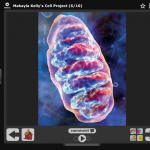Summary
For this lesson students were asked to create a Voicethread to demonstrate their knowledge of cell structure & function. Students could choose between a plant or animal cell. They were asked to use advance Google searches in order research the different parts of the cell and then create a digital presentation illustrating the various cell organelles accompanied by voice dialogue or written text. Once the VoiceThread was complete it was published to be shared and commented with the world at large. At the conclusion of the project the class was asked to reflect on their roles.
TIPC Ratings
Ideal: Students applied research skills that were guided by the teacher through the use of performing an Advanced Google Search. The teacher modeled specific strategies to guide the students in their investigations. The teacher model allowed for the students to place restrictions on their searches. For example, they could search by keywords, domain, recent updates, reading level, etc. Information and citations were recorded on a graphic organizer. Students were responsible for constructing their own questions to help guide their research.
Ideal: Students were allowed to work in self-selected groups or on their own. Ultimately, all students will have the option to receive advice and feedback from their peers and teacher upon the completion of the project. Students were urged to use VoiceThread as their means of communication, but other tools were allowed as suggested by students. VoiceThread allows for students to comment on one anothers work via. moderated comments. Students are also provided with public link that they can use to share their creations outside the classroom walls with a wider audience. The project also added a reflection piece via. a Google form where the students had to reflect on the overall outcome of their project.
Approaching: Students were assigned the real – world task of creating an informative voicethread to help younger elementary students as well next year’s incoming class understand the composition and make-up of plant and animal cells. Students synthesized the information they had learned pertaining to cell structure and function in order to complete this project. Students we teach today come to the classroom already having been familiar with social media and web 2.0 tools. VoiceThread is a tool with a limited learning curve which allows for students to devote their time to content rather than how to manipulate the tool.
Approaching: Creativity can be witnessed in the students final products. The students were instructed to use a graphic organizer while gathering data, but were given very few limitations as to the final product. Reflection and feedback was provided when end products were shared with their peers for review. This is a good example of students teaching students. The real world application includes the fact that these products would shared with next year’s class to help them understand the composition of a cell.
Download Files
REPLACE THIS TEXT WITH THE CODE FOR THE LINKED FILE
Contents:




